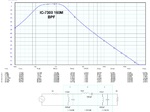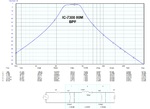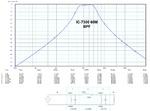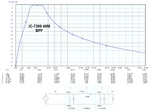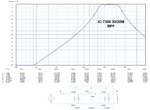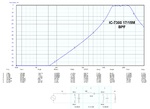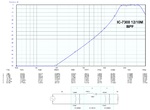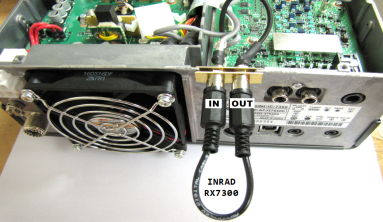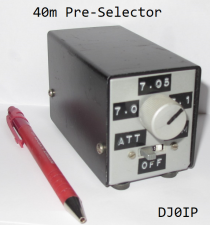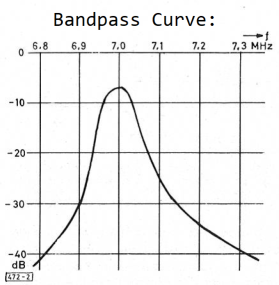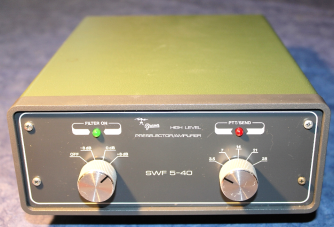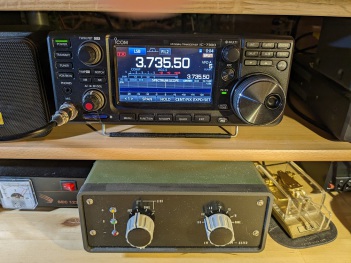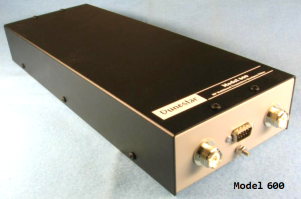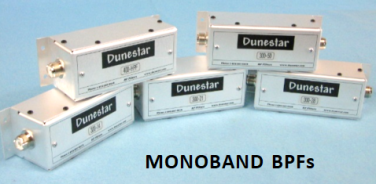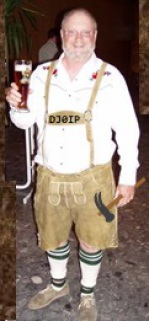7300 Bandpass Filters - Pre-Selectors
Bandpass Filters (BPF):
Many SDR radios shipping today have very little front-end filtering. In fact many have just a single Low Pass Filter (LPF) at the top of the hf spectrom. This is intentional to enable monitoring a larger slice of the hf spectrum at one time.
For amateur radio use, dedicated bandpass filters BPF's are required in order to obtain good ham-band performance, with minimum interference from the strong out-of-band shortwave broadcast stations. This is especially true here in Europe.
The 7300 has bandpass filters for the ham bands, but in some cases they are relatively broad. Here in Europe it is advantageous to use a Pre-Selector with the 7300.
The bandpass curves for each of the 7300's BPF for the hf bands are shown in the graphs below. The graphs are courtesy of Clint Chron, W7KEC.
GALLERY:
PRE-SELECTORS:
Region-One (Europe) has always been a much harscher environment on the HF bands than
Region-Two (N./S. America). This is due to the numerous high-power shortwave broadcast stations operating here. A second problem 'was' that the
Region-One 40m band was only 100 kHz wide (7.000 to 7.100 MHz).
In March of 2009, the ITU expanded the Region-One 40m ham band to 7.200 MHz, and gave hams exclusive priviliges from 7.000 to 7.200 MHz. It required all broadcast stations to move out of the ham band.
Obviously things got a lot better after that.
THE PROBLEMS were Twofold:
- Receiver Front-End Overload - primarilly on 160/80/40m
- 20m Interference - only on 20m
RX-Overload: I called this an IP3 problem. It was caused by the sum of the RF from all of the broadcast stations overloading the front end of the receiver. This could be eliminated by lots of attenuation (i.e., 20dB or more, depending on the performance of the receiver), but that also made it impossible to hear weak DX signals. Receivers in the previous century typically had 3rd order dynamic range (DR3) in the 50's and 60's dB; good receivers' DR3 was in the 70's. A pre-selector worked magic with these receivers.
20m Interference: I called this an IP2 problem. This was caused by a broadcast station on the 41m band (~6 MHz) hetrodyning together with a broadcast station on the 49m band (~8 MHz), resulting in a signal on the 20m band (~14 MHz). The result was a strong audible carrier every 10 kHz on the 20m band. How strong these carriers were depended on the 2nd order dynamic range (DR2) of the receiver. The difference between different radios was enormous. Radios like the IC-706 used with a good antenna (especially a multi-band antenna) were basically unusable on 20m at night; most carriers were 59 to 59+20dB).
THE CURE: BANDPASS FILTERS (BPF)
There are different kinds of BPFs.
- Broadband RX BPF with fixed bandwidth (with several MHz bandpass, as used in the front-end of the IC-7300; see bandpass curves above).
- Band-Specific RX BPF with fixed bandwidth (slightly broader bandpass than the ham band), as used in many of the transceivers with downward conversion (i.e., low frequency 1st IF, such as 9 MHz or 5 MHz). These are also used in many Pre-Selectors.
- Tunable RX BPF with either a narrow, fixed bandpass ... or ... a bandpass slightly larger than the ham band.
- TX BPF with a bandpass slightly broader than the ham band. These have the advantage that you can transmit through them, whereas the RX (only) BPFs when inserted directly in the antenna feedline must be bypassed when transmitting. Exception (as I have done in my IC-7300), the RX (only) BPF may be inserted downstream in the RX circuitry, thus the transceiver's own T/R relay prevents transmitting through them.
Over the years I have used all of the above. I have ALWAYS inserted my RX-only BPFs (a.k.a., external Pre-Selector) downstream in the RX circuitry, so as not to have to switch it out when transmitting. This is especially useful when running full QSK CW.
CONNECTING THE PRE-SELECTOR TO THE IC-7300:
To avoid having to switch the pre-selector in and out when receiving/transmitting, I first purchased the INRAD RX7300 receive-only antenna jack and loop mod. This option provides two RCA phono jacks on the real panel for connecting a pre-selector.
WARNING: Do not use this mod to connect a RX-only antenna, unless you provide for switching the RX-only to ground during transmit (using a relay). Failure to do this may result in destroying the downstream RX circuitry.
However, connecting a pre-selector in this loop is not a problem. There is no antenna connected directly to the preselector. The radio uses the TX antenna for RX, and it is switched out of the RX circuit with the radio's T/R relay.
Unfortunately, it seems INRAD no longer has this option in their product portfolio.
LATER I purchased a similar device on ebay, sold by a French ham. It was identical to the INRAD option, except it used SMA connectors rather than RCA phono plugs.
The RX7300 jacks mount on the back panel in place of the EXT. ATU connector. The ATU connector is simply pushed inside of the radio (and insulated with tape).
- Connect OUT jack to the filter input.
- Connect filter output to IN jack.
When the RX7300 is not in use, jumper OUT to IN using the jumper included with the RX7300.
MY EXTERNAL BPFs:
40m Tunable Pre-Selector:
With 40m being my favorite band, in the 1970s I built a tuneable 40m Pre-Selector with a very narrow bandwidth (abt. 50 kHz) and a tuneable bandpass center-frequency.
I copied the 2-stage tunable circuit described By Thomas Molier, DL7AV, that was published in the November 1974 issue of the German "CQDL" magazine on pages 642 to 646.
(Note: Page numbers begin with page 1 in January and end with page 800 or so in December issues).
I built this BPF while I was working as a technician in the RF Lab at Rhode und Schwarz in Berlin. The test equipment in the lab enabled me to adjust the BPF and measure its characteristics.
The filter only works on 40m. The 3-position slider switch on the front panel switched to BYPASS in the center position, Filter-In in the right position, and bypass with -10 dB in the left position. The additional attenuation was sometimes needed on bands where the radio's built-in attenuation was insufficient.
The 2-stage circuit uses inductors wound on pot-cores.
40m Bandpass Characteristics
This filter has an insertion loss of -6.5 dB, with
- -3 dB bandwidth of 55 kHz,
- -10 dB bandwidth 120 kHz,
- -44 dB at -350 kHz,
- and -36 dB at +250 kHz.
By tuning the center of the passband below the 40m band, I could reduce the signal strength of Radio China (which was inside the 40m band) significantly, without excessive loss of signal strength to signals in the CW segment of the band.
Download the original CQDL article here:
Obviously this article was written in German. Although it won't be much use to most readers, at least you can see the schematic diagram of the tunable filter. Tuning is accomplished with a small VHF variable capacitor.
40m Preselector by DL7AV.pdf
PDF-Dokument [1.3 MB]
BRAUN SWF 5-40 PRE-SELECTOR
This is a 2-stage 5-band pre-selector covering the 5 classic HF bands (80/40/20/15/10m). It uses pot-core coils, enabling excellent performance. Hams considered it the best pre-selector in its day (19702/1980s).
I also bought an external mono-band pre-selector for 160m. It was a passive device in a small metal inclosure having only two jacks and no controls. I had
to manually connect it when working 160m.
DOWNLOAD INSTRUCTION MANUAL WITH SCHEMATIC:
HOME BREW BRAUN CLONE:
This home brew pre-selector is pretty much an exact copy of the Braun SWF 5-40 pre-selector, except it uses Toroid cores instead of pot-cores. This home brew version includes the 160m BPF
built-in.
The built in preamp/attenuator switch has 4 positions: Off/+6dB/0dB/-6dB.
In theory it is not quite as good as the Braun, but in practice I don't hear a difference.
I kept this instead of the Braun because it has160m; the Braun did not.
I bought this pre-selector used. It was built by another ham.
I pulled the pre-selector out as far as I could from under the shelf before taking this photo. I see from the dust on the cabinet that it's time once again for a good spring cleaning of all equipment in the shack! The 7300 and IC-2KL wear dust covers when not in use . . . as does the IC-7100.
DOWNLOAD SCHEMATICS:
DUNESTAR TX BPFs:
The MODEL 600 is a 6-band TX bandpass filter covering the 160/80/40/20/15/10m HF bands.
This is a 100 Watt version and must be inserted between the transceiver and the linear amplifier.
Its BPFs are identical to the mono-band filters and have an insertion loss of less than 1 dB. The rejection between bands is 40 dB.
I did a lot of team contesting (multi/single, multi/multi) in the 1990s and early 2000s. These TX BPFs were worth their weight in gold. In the meantime, inflation has driven the price of thes BPFs to about that of gold! I sold mine for more than I had paid for them about 15 years after I bought them.
On the lighter side . . . 'these filters' were a good investment but now days 'eggs' are an even better investment! Eggscuse me folks . . . couldn't resist that! (hi)
To be continued; Rome was not destroyed in a single day!

